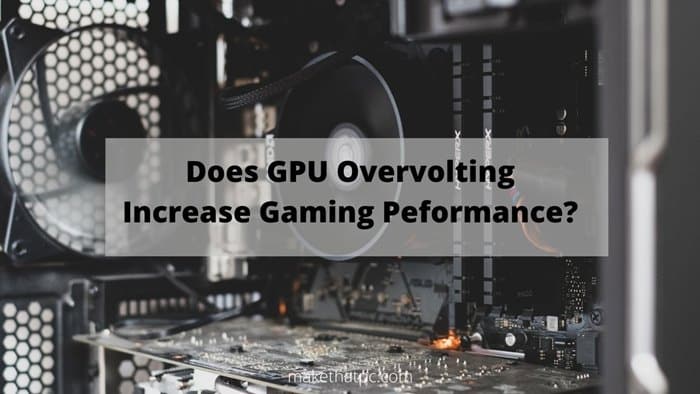Are you a hardcore gaming enthusiast?
Do you want to play high-end games but you don’t have the budget to purchase an insanely premium-spec PC? So, the only option for you is to overclock the system’s GPU, isn’t it?
For starters, overclocking your graphics card means gradually increasing the clock speed of your video card to boost its performance. Now, If you want to overclock your GPU, you need to provide it with more voltage to function. And, this very process of providing more voltage is commonly known as Overvolting.
In simple words, overclocking your GPU will increase gaming performance and will offer you higher FPS possibly. Just increasing the input voltage (overvolting) alone will not enhance your gaming performance. In fact, it will result in unwanted voltage inputs to your GPU and sometimes cause several problems. In other words, you should try to properly overclock using the core clock and memory clock in consideration. Do not just increase the input voltage and expect high FPS.
In case all of this sounds ‘gibberish’ to you, do not fret! We’re here to break it down even further…. Keep scrolling to know whether overvolting can really boost the gaming performance.

WHAT IS OVERVOLTING?
As discussed moments ago, overvolting is the way in which you increase your GPU’s voltage beyond its intended specifications. When you overvolt, you are increasing the power more than your system can output during any operation.
GPU Overvolting actually works in conjunction with GPU overclocking. So, when you increase your GPU’s core-clock frequency, and memory clock, more voltage is required to fulfill those higher demands. So, we increase the input voltage. So, you can’t increase the voltage only and expect higher performance. The voltage will increase after increasing the core clock.
So, if you want to experience high-end games on a comparatively lower-spec GPU, the only way possible is to overclock it. To do that, you will have to provide it with more voltage, so you can successfully overvolt your system.
(For an overview of how to overclock your GPU, you can visit the following link
SHOULD YOU OVERVOLT?
Overvolting is something we never recommend to anyone. However, it is the only possible solution for someone who is hell-bent on achieving a system capable of running games and programs that their base system cannot.
If you decide on going really extreme on the overclocking though, overvolting may be the only way that your PC can handle the excess action in terms of clock speeds. By doing this, you will make the overclocking far more stable and the crashes that might’ve been happening will be far less frequent. The result should be a more stable PC that can run your games and programs with higher graphics and more frames per second than you previously might have had.
That being said, Overvolting is one of the more popular practices in the PC tweaking universe and if you explore online, you will see tons of PC users and gamers who sing the praises of powering up your PC in this way.
Every now and then you might see a warning story or two about people that Overvolted too far and ended up with a fried GPU. But most of the time, as long as you are sticking to a strict practice of only raising the curve a slight amount each time you try to increase the voltage, you should end up with a more stable unit overall.
Also Read: How to increase GPU performance without overclocking?
HOW TO OVERVOLT?
To initiate overvolting, the first thing we are going to need is a program that allows us to access the voltage of our computer. There are a few out there, one of them is MSI Afterburner.
With this program, we get a simple menu page with the various sections of the computer at our disposal that we can fiddle with. You have the leverage to overclock the memory and GPU, increase temperature limits, change the fan speeds and also change the voltage.
Watch this YouTube video to know how you can properly overclock and overvolt your GPU.
The core voltage setting is our main focus here. There is a curve editor where we can see what the current voltage is and this is where we can begin tweaking.
When beginning this task, you should always make sure the voltage does not get lower than 200 mV or too high at any point. Many graphics cards will tell you what voltage they can handle, so a bit of research is necessary before you decide to go all in.
You really just need to “tweak and test and tweak and test” until you feel you have a stable system in place. There is no definitive answer as to how much you can overvolt.
In case you choose to overclock as well as Overvolt, you need to know you are treading on some pretty tenuous ground here as you are going to be putting your system through the ringer. If you go too high on both at the same time, the result can be a completely broken GPU which is not something you would like to deal with!
For starters, go incrementally when changing the curve. The smart move here is to raise it a little bit at a time and then use a benchmark program such as Superposition Benchmark to test how your system reacts to the changes.
While initial testing might show positive results, run your system for 5-10 minutes at least to really see what the impact is!
If you’re coming in well above the temperature limit that your PC normally has, you have gone too far and need to tone the Overvolting back to avoid any major problems.
THE CONS OF OVERVOLTING
The dangers of Overvolting are fairly high in terms of what it can do to your system without proper care. Without careful directions, you could easily overvolt too much and the result can be ruined expensive equipment.
The best advice to give you in this regard is to be patient. Go step-by-step and don’t rush, as every graphics card is different and some can handle a higher overvolting than others. There is no one-size-fits-all solution when tweaking the voltage curve, so you’re going to have to be vigilant in testing and researching as well.
FINAL THOUGHTS
To sum it up for you, the effects of the Overvolting aren’t going to be very readily apparent. The system for tweaking voltage these days is far more structured than it used to be, making it a much safer practice. If you absolutely must overclock your PC to crazy high levels, then definitely consider overvolting alongside it to make sure your PC doesn’t crash consistently.
As with any type of PC adjustment, the possibility that your whole system could end up completely wrecked and useless if you’re not careful.
As far as benefits outweighing the risks with Overvolting, that all depends on how careful you are willing to be. If you have the patience to tweak incrementally, benchmark, rinse and repeat f until you find the sweet spot that works both with performance and stability, then, by all means, give it a shot. But this isn’t the same thing as Overclocking and even the slightest miscalculation can end with a bricked system.
For the record, real disasters usually occur with people who just aren’t satisfied with “good enough”. So do some research on your system, and find out if your equipment can handle overvolting. If things get too rough while overvolting, you can always under-volt your system to cool things off, all while getting a similar performance.

I am Anshul Rana, an experienced author specializing in PC gear reviews and Windows 10 software tutorials. With a strong passion for technology and an in-depth understanding of the PC industry, I provide insightful and detailed analyses of computer peripherals, gaming gear, and software solutions. My writing style is concise yet informative, making complex topics accessible to both beginners and advanced users. Through my reviews and tutorials, I aim to offer valuable guidance, helping readers make informed decisions to enhance their PC experience and explore the vast possibilities of Windows 10 software.









